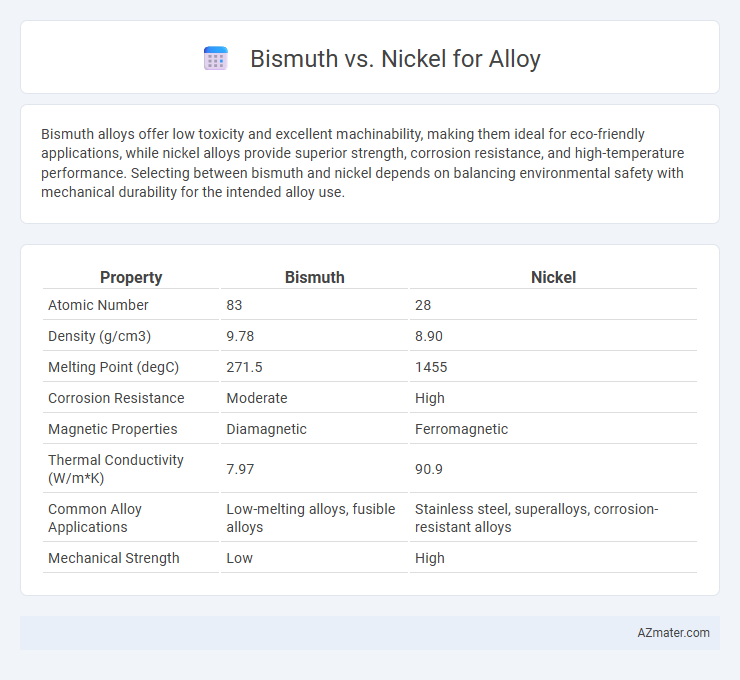Bismuth alloys offer low toxicity and excellent machinability, making them ideal for eco-friendly applications, while nickel alloys provide superior strength, corrosion resistance, and high-temperature performance. Selecting between bismuth and nickel depends on balancing environmental safety with mechanical durability for the intended alloy use.
Table of Comparison
| Property | Bismuth | Nickel |
|---|---|---|
| Atomic Number | 83 | 28 |
| Density (g/cm3) | 9.78 | 8.90 |
| Melting Point (degC) | 271.5 | 1455 |
| Corrosion Resistance | Moderate | High |
| Magnetic Properties | Diamagnetic | Ferromagnetic |
| Thermal Conductivity (W/m*K) | 7.97 | 90.9 |
| Common Alloy Applications | Low-melting alloys, fusible alloys | Stainless steel, superalloys, corrosion-resistant alloys |
| Mechanical Strength | Low | High |
Introduction to Bismuth and Nickel in Alloys
Bismuth and nickel play distinct roles in alloy composition, with bismuth valued for its non-toxic, low-melting properties that enhance machinability and environmental safety in alloys such as lead-free solders and bearing metals. Nickel contributes exceptional strength, corrosion resistance, and high-temperature stability, making it a critical component in stainless steel, superalloys, and aerospace materials. The contrasting physical and chemical characteristics of bismuth and nickel enable customized alloy solutions tailored to specific industrial applications.
Physical Properties Comparison: Bismuth vs. Nickel
Bismuth exhibits low thermal conductivity (7.97 W/m*K) and a high electrical resistivity (1.28 x 10^-5 O*m), contrasting sharply with nickel's high thermal conductivity (90.9 W/m*K) and low electrical resistivity (6.99 x 10^-8 O*m). Bismuth has a notably low melting point of 271.5degC compared to nickel's high melting point of 1455degC, making bismuth alloys suitable for low-temperature applications. The density of bismuth (9.78 g/cm3) is slightly lower than nickel's density (8.91 g/cm3), which can influence alloy weight and structural properties.
Chemical Characteristics in Alloy Formation
Bismuth exhibits low solubility and immiscibility with most metals, leading to the formation of brittle intermetallic compounds when alloyed with nickel. Nickel's strong affinity for forming substitutional solid solutions contrasts with bismuth's tendency to segregate at grain boundaries, impacting the alloy's mechanical properties and corrosion resistance. Chemical characteristics such as atomic size, electronegativity, and valence electron differences dictate the limited mutual solubility and influence phase stability in Ni-Bi alloys.
Common Industrial Applications
Bismuth-nickel alloys are prominently used in low-melting point applications such as solders and fusible plugs due to their excellent thermal properties and non-toxic nature. Nickel-based alloys are widely favored in high-strength, corrosion-resistant environments, including aerospace, chemical processing, and marine industries. Combining bismuth and nickel enhances machinability and wear resistance, making the alloy suitable for specialized industrial components where both durability and ease of fabrication are critical.
Thermal and Electrical Conductivity Differences
Bismuth alloys exhibit significantly lower thermal conductivity, around 8 W/m*K, compared to nickel alloys which range from 60 to 90 W/m*K, making bismuth preferable for heat insulation applications. In terms of electrical conductivity, bismuth's resistivity is much higher, approximately 1.3 x 10^-5 O*m, whereas nickel alloys have lower resistivity near 7 x 10^-7 O*m, resulting in superior electrical conduction. These differences influence alloy selection in electronics and thermal management, favoring nickel for efficient conduction and bismuth for thermal barrier purposes.
Environmental Impact and Sustainability
Bismuth alloys are favored over nickel alloys for environmental sustainability due to Bismuth's non-toxic, biodegradable nature and lower ecological footprint during extraction and processing. Nickel mining involves high energy consumption and significant pollution, including heavy metal contamination, making Bismuth a more eco-friendly alternative in alloy applications. Using Bismuth in alloys reduces environmental hazards and supports sustainable manufacturing practices aligned with green chemistry principles.
Cost and Economic Considerations
Bismuth alloys typically incur higher raw material costs due to bismuth's relative rarity compared to nickel, making nickel-based alloys more cost-effective for large-scale production. Nickel offers better economic value in applications requiring durability and corrosion resistance, reducing long-term maintenance expenses. The choice between bismuth and nickel alloys significantly impacts overall project budgets, where bismuth's specialized properties justify its premium in niche markets.
Corrosion Resistance in Various Environments
Bismuth alloys exhibit superior corrosion resistance in acidic and reducing environments due to their non-toxic, stable oxide layer, which prevents metal degradation. Nickel-based alloys provide excellent corrosion resistance across a wide range of harsh environments, including oxidizing acids and high-temperature conditions, attributed to their robust passivation layer of nickel oxide. Selecting between bismuth and nickel for alloy composition depends on the specific environmental conditions, with nickel preferred for extreme industrial applications and bismuth favored for less aggressive, eco-friendly corrosion resistance solutions.
Alloy Strength and Durability Factors
Bismuth alloys typically exhibit lower strength and durability compared to nickel-based alloys due to bismuth's brittle nature and lower melting point. Nickel enhances alloy strength and corrosion resistance, making nickel alloys preferable for applications requiring high mechanical performance and long-term durability. The incorporation of nickel into alloys significantly improves tensile strength, fatigue resistance, and wear properties compared to bismuth-containing alternatives.
Choosing Between Bismuth and Nickel for Specific Alloys
Choosing between bismuth and nickel for specific alloys depends on the required properties like melting point, toxicity, and malleability. Bismuth alloys offer low toxicity and excellent machinability, ideal for applications needing non-toxic and environmentally safe materials, while nickel alloys provide superior strength, corrosion resistance, and heat tolerance suitable for high-performance, structural, or heat-resistant uses. Selecting the right metal involves balancing bismuth's eco-friendly nature and nickel's mechanical robustness to meet specific industrial demands.

Infographic: Bismuth vs Nickel for Alloy
 azmater.com
azmater.com